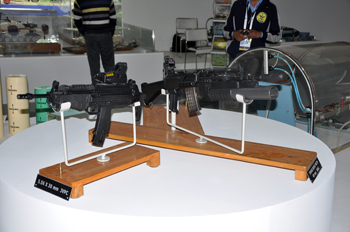INDIAN ARMED FORCES CHIEFS ON OUR RELENTLESS AND FOCUSED PUBLISHING EFFORTS

The insightful articles, inspiring narrations and analytical perspectives presented by the Editorial Team, establish an alluring connect with the reader. My compliments and best wishes to SP Guide Publications.

"Over the past 60 years, the growth of SP Guide Publications has mirrored the rising stature of Indian Navy. Its well-researched and informative magazines on Defence and Aerospace sector have served to shape an educated opinion of our military personnel, policy makers and the public alike. I wish SP's Publication team continued success, fair winds and following seas in all future endeavour!"

Since, its inception in 1964, SP Guide Publications has consistently demonstrated commitment to high-quality journalism in the aerospace and defence sectors, earning a well-deserved reputation as Asia's largest media house in this domain. I wish SP Guide Publications continued success in its pursuit of excellence.
- Appointments Committee of Cabinet approves one-month extension in service of Chief of the Army Staff
- Prime Minister witnesses 'Bharat Shakti' – a Tri-Services Firing and Manoeuvre Exercise in Pokhran, Rajasthan
- Interim Defence Budget 2024-25 — An Analysis
- Union Defence budget 2024
- Indian Army: In quest of greater firepower and policy recommendations for gaps
- Indian Army Annual Press Conference 2024
- Tata Boeing Aerospace Delivers 250 AH-64 Apache Fuselages, Manufactured in India
Excalibur — Stopgap or final?
 |
By Lt. General P.C. Katoch (Retd) Former Director General of Information Systems, Indian Army |

5.56 x30mm JVPC and INSAS rifle with 40mm UBGL
It was only four months back (July 2016) when media reported that the Army junked DRDO's 5.56mm Excalibur assault rifle. Resultantly, Army's quest for a state-of-the-art assault rifles got been extended. It may be recalled that the global tender floated in 2011 (with MoD approval) for new generation assault rifles with interchangeable barrels for conventional warfare and CI operations was finally scrapped in June 2015 despite being termed "Priority I" for the 382 infantry battalions. Reputed foreign firms participated in the trials for the double-barrel rifles, Army having taken conscience decision to go for interchangeable barrels, which had MoD approval.
The plan was direct acquisition of 65,000 new generation rifles costing Rs 4,848 crores to equip 120 infantry battalions. OFB was to then manufacture over 1,13,000 such rifles through JV with the foreign vendor providing ToT. The rifle was to weigh around 3.5 kgs with advanced night-vision, holographic reflex sights, laser designators, detachable under-barrel grenade launchers etc. Ironically, 65,000 new generation rifles costing Rs 4,848 crores could have been imported in 2011-2012 to equip 120 infantry battalions, and DRDO-OFB would still have had the pie of producing over 1,13,000 such rifles through a JV under 'Make in India', but that was not to be. Army's cutting edge includes 380 Infantry Battalions and 63 Rashtriya Rifles (RR) Battalions — some 4.8 lakh foot soldiers. It is not that the type of assault rifle the Army sought was not available globally, but what caused the tender to be scrapped was the DRDO coming up with the 'Improved 5.56 INSAS' dubbed Excalibur, which had been under development past several years. The sponsored media then had indirectly blamed the Army for junking the Excalibur by saying, "The military wisdom till now was that the 5.56mm rifle was better for conventional war because it injured the enemy soldier, tying down at least two of his colleagues to carry him. Conversely, the 7.62mm rifle was better for counter-insurgency since terrorists had to be killed at the first instance, eliminating the risk of suicide bombing'. However, the decision to junk the Excalibur obviously had more to do with the overall performance of the "improved INSAS", numerous previous attempts to 'improve' and rectify defects having proved only cosmetic.
It is not the first time that the infantry has suffered such setback. In 1980, 17 x 5.56mm rifles from 11 countries were imported by MoD to equip 3 x Parachute Commando battalions and 3 x Parachute Battalions. Despite successful trials, the red tape and mafia blocked imports, giving these 17 weapons to DRDO who took 15 years to produce the 5.56 INSAS rifle that was nowhere close to top 10 assault rifles of the world. The IPKF went to Sri Lanka in 1987 armed with the unwieldy 7.62 SLR rifles battling the LTTE armed with AK 47 assault rifles. Eventually, Army had to import 1,00,000 AK 47 rifles (then costing only US$ 300 apiece) to give 100 per infantry battalion in the IPKF. The Infantry is ladled with DRDO's 5.56 INSAS rifles for past two decades which still has over a dozen faults. Because of frequent stoppages, frontline soldiers in Siachen area keep an AK-47 next to the INSAS because of former's much better reliability during critical moments. DRDO's small arms record has been very dismal; 5.56 INSAS, light machine gun and medium machine guns. Ironically, 65,000 new generation rifles costing Rs 4,848 crores could have been imported in 2011-2012 to equip 120 infantry battalions, and DRDO-OFB would still have had the pie of producing over 1,13,000 such rifles through a JV under 'Make in India', but that was not to be. Army's cutting edge includes 380 Infantry Battalions and 63 Rashtriya Rifles (RR) Battalions — some 4.8 lakh foot soldiers.
Army's critical voids in small arms include: over two lakh new generation assault rifles; over 1.6 lakh close-quarter battle (CQB) carbines; over 1600 light machine guns, and; over 3,500 specialized sniper rifles. The Army imported 5.56 Tavor Assault Rifles ex Israel for the Para (SF) and Para units but due to unprecedented expansion of Para (SF) these units presently hold a mix of Tavor, INSAS and AK-47 rifles. There is serious shortage of Tavor ammunition, even for training. The Army had reportedly decided to go for 7.62mm calibre and fresh General Staff Quality Requirements (GSQR) were issued. Media reports state, "The RFI (request for information) for the new 7.62mm assault rifles to invite bids", but knowing the red tape and long winded procedures, it may yet take seven-eight years, if at all the follow up is permitted; considering the games played past several decades and the hurdles, pitfalls and efforts to scuttle equipping (any and every time before actual fielding) for multiple reasons? The indications are already there with latest media reports that "faced with a huge delay in acquiring world-class rifles for its soldiers, the Army is now reluctantly planning to induct the indigenously developed Excalibur, an assault rifle it had initially rejected, though in limited numbers." It can perhaps be taken for granted that any future efforts by the army to import assault rifles will be scuttled any which way. The Excalibur is not likely to be stopgap, it would be final. The CAPF can continue to import better assault rifles and why not when the present dispensation places them over the military.
Photo Credit: SP Guide Pubns





